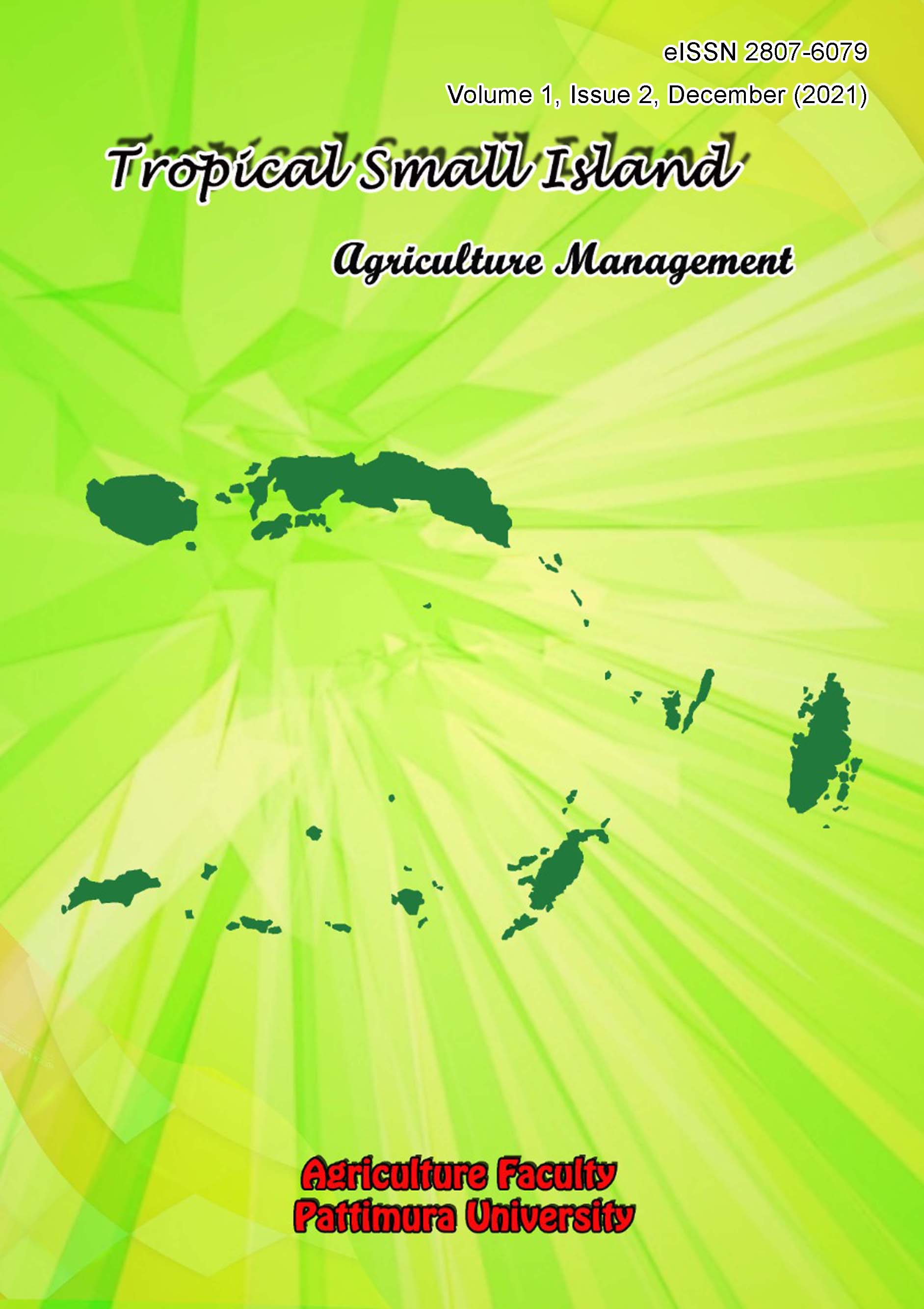Penggunaan Akar Tanaman Antagonis Untuk Menekan Puru Akar Oleh Nematoda (Meloidogyne spp) Pada Tanaman Tomat (Lycopersicum Esculentum Miller.)
Use Antagonistic Plant Roots to Suppress Root Knots by Nematodes (Meloidogyne Spp.) on Tomato Plants (Lycopersicum esculentum Miller.)
Abstract
This research aims to determine the effect of antagonistic plant roots in suppressing the formation of root knots by nematodes on tomato plants. This research used a Completely Randomized Design (CRD) consisting of 5 treatments and 5 replications. This research was carried out in Negeri Rumah Tiga, Teluk Ambon District. The research results showed that castor root extract (Recinus communis Linn.) was better than areca root extract (Areca catchu Linn.) and papaya root extract (Carica Papaya Linn.) in suppressing the growth of root knot nematodes on tomato plants (Lycopersicum esculentum Miller. ). Secondary metabolism contained in castor root extract (Recinus communis Linn.) has an effect in suppressing root length growth by 24.46 cm, while the substances contained in papaya root extract (Carica papaya Linn) suppress root length growth by 14.34 cm. The root weight of the tomato plant, Moringa oleifera Linn.) root extract weighed 0.8 grams, while the lowest was the kenikir (Cosmos caudatus Linn.) root extract with a root weight of 0.23 grams. Castor root extract (Recinus communis Linn.) from areca root extract (Areca catchu Linn.) and papaya root extract (Carica papaya Linn.) in suppressing the growth of root knot nematodes on tomato plants (Lycopersicum esculentum Miller.). The damage value of areca root extract (Areca catchu Linn.) and papaya root extract (Carica papaya Linn.) have the same high damage value, namely 2.2, while castor root extract (Recinus communis Linn.) has a low damage value of 1.2.
Downloads
References
Abad, P., Favery, B., Rosso, M., & Castagnone-Sereno, P. (2003). Root-knot nematode parasitism and host response: Molecular basis of a sophisticated interaction. Molecular Plant Pathology, 4(4), 217-224. https://doi.org/10.1046/j.1364-3703.2003.00170.x
Adawiyah, R., & Rizki, M.I. (2018). Aktivitas antioksidan ekstrak etanol akar kalakai (Stenochlaena palustris Bedd) asal Kalimantan Tengah. Jurnal Pharmascience, 5(1), 71-77. https://ppjp.ulm.ac.id/journal/index.php/pharmascience/article/view/5788
Azhar, N.O., Winarto, & Reflinaldon (2017). Pengaruh waktu aplikasi Paecilomyces spp. terhadap penekanan nematoda bengkak akar (Meloidogyne spp.) pada tanaman tomat (Lycopersicum esculentum Mill.). JPT: Jurnal Proteksi Tanaman, 1(2), 88-94. https://doi.org/10.25077/jpt.1.2.88-94.2017
Damayanti, A.P., Rahardjo, B.T., & Tarno, H. (2018). Pengaruh pemberian plant growth promoting rhizobacteria (Psudomonas fluorescens) terhadap nematoda puru akar Meloidogyne sp. pada tanaman tomat. HPT, 6(1), 26-34. https://jurnalhpt.ub.ac.id/index.php/jhpt/article/view/269
Jones, B. (2008). Tomato Plant Culture in The Field, Greenhouse, And Home Garden, Second Edition. CRS Pers: New York.
Laras. (2018). Efektivitas Ekstra Daun Kelor (Moringa oleifera L.) Dalam Pengendalian Ulat Krop (Crocidolomia pavonana F.) Pada Tanaman Kubis (Brassica oleracea L. var. capitata). Skripsi. Bandar Lampung. Fakultas Tarbiyah Dan Keguruan Universitas Islman Negeri Raden Intan Lampung.
Mursito, B. & Prihmantoro, H. (2011). Tanaman Hias Berkhasiat Obat. Penebar Swadaya. Jakarta.
Mustofa, A. I., Purnomo, D., & Sakya, A. T. (2018). Pertumbuhan dan hasil kubis bunga pada sistem hidroponk substrat dengan media bagase. Agrotech Research Journal, 2(1), 6–10. https://doi.org/10.20961/agrotechresj.v2i1.17342
Ningrum, R., Purwanti, E., & Sukarsono. (2016). Identifikasi senyawa alkaloid dari batang karamunting (Rhodomyrtus tomentosa) sebagai bahan ajar biologi untuk SMA Kelas X. Jurnal Pendidikan Biologi Indonesia, 2(3), 231-236. https://ejournal.umm.ac.id/index.php/jpbi/article/view/3863
Nugraha, J. (2020). 40 Mengatasi Masalah Pencernaan di Dalam tubuh. Inspiratif dan Penuh Makna. (Diakses Desember 2021)
Oktavia, E., Winarto, & Sulyanti, E. (2021). Aktivitas ekstrak daun jarak kepyar (Ricinus communis Linnaeus) terhadap perkembangan nematoda Meloidogyne spp. pada tanaman tomat (Lycopersicum esculentum Miller). JPT: Jurnal Proteksi Tanaman, 5(1), 34-45. https://doi.org/10.25077/jpt.5.1.34-45.2021
Pitojo. S. (2005). Benih Tomat. Kanisius. Yogyakarta.
Safitri. (2021). Tomat, Usaha Tani dan Penanganan Pasca Panen. Kanisus. Yogyakarta.
Sari, A.M. (2018). Korelasi Jumlah Air Pengekstrak Terhadap Aktivitas Antioksidan Ekstrak Daun Kelor (Moringa oleifera). Skripsi. Fakultas Teknik. Universitas Pasundan.
Sikder, Md.M. & Vestergård, M. (2020). Impacts of Root Metabolites on Soil Nematodes. Frontiers of Plant Science, 10, 1792. https://doi.org/10.3389/fpls.2019.01792
Suharti, Banowati, A., Hermana, W. & Wiryawan, K.G. (2008). Komposisi dan kandungan kolesterol karkas ayam broiler diare yang diberi tepung daun salam (Syzygium polyanthum Wight) dalam ransum. Media Peternakan, 31(2), 138-145. https://journal.ipb.ac.id/index.php/mediapeternakan/article/view/1095
Yulianamawar. (2019). Uji Aktivitas Antihelmintik Ekstrak Akar Pepaya (Carica papaya L.) Terhadap Cacing Ascaris suum (Studi Invitro). Skripsi. Universitas Muhammadiyah Surakarta.
Copyright (c) 2024 The Author(s)

This work is licensed under a Creative Commons Attribution-ShareAlike 4.0 International License.
Authors who publish with this journal agree to the following terms:
- Authors retain copyright and grant the journal right of first publication with the work simultaneously licensed under a Creative Commons Attribution License that allows others to share the work with an acknowledgment of the work's authorship and initial publication in this journal.
- Authors are able to enter into separate, additional contractual arrangements for the non-exclusive distribution of the journal's published version of the work (e.g., post it to an institutional repository or publish it in a book), with an acknowledgment of its initial publication in this journal.
- Authors are permitted and encouraged to post their work online (e.g., in institutional repositories or on their website) prior to and during the submission process, as it can lead to productive exchanges, as well as earlier and greater citation of published work (See The Effect of Open Access).









